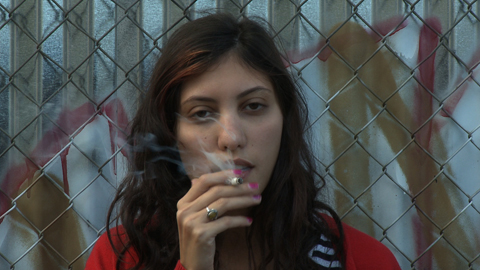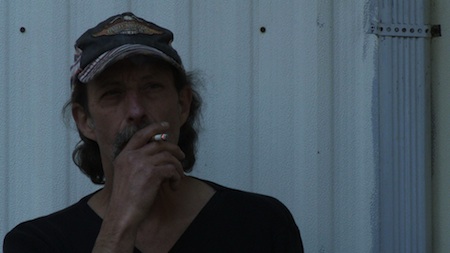As expected, twenty cigarettes are consumed in James Benning’s latest experimental feature, 20 Cigarettes (2011). In a series of portraits that borrow from (as Benning has explained in interviews) but also depart from Andy Warhol’s iconic Screen Tests, the film features smokers standing alone before the camera. Each of the twenty shots — the number for a standard pack of cigarettes–lasts as long as it takes for the smoker to finish. Framed in tight medium shots, however, the cigarettes are usually only glimpsed when raised to the mouth, or, in the case of the first portrait, that of novice smoker Sompot Chidgasornpongse in Bangkok, regarded with wary curiosity. Here, as with Warhol, the focus is on the face: the tics, the sighs, the slackening that occurs mid-drag. Less visible but more palpably felt, 20 Cigarettes is, like Benning’s previous landscape studies, a meditation on duration, the minute changes that occur over time, and the retraining of a viewer’s attention.
Despite the film’s minimalist compositions, which reveal little about the identities or even geographical locations of Benning’s subjects until they’re named in the end credits, the standing posture of the solitary smokers invoke the act, as well as the time, of the smoke break. Benning has remarked that the type of smoking in his film is unusual: “People don’t smoke like that, standing up and just staring forward — the only exception might be workers on a smoke break standing outside a building.”[i] Many of the locations suggest sites of work: we imagine a factory when we see a background sheet of plywood, a restaurant when we hear the din of clattering dishes, and, with the tinny techno sound of Debbie Harry’s “Ghost Riders in the Sky” reverberating off a corrugated metal wall, a nightclub. The smokers stand near or just outside their places of work, often outdoors and in daylight. Occasionally we hear, and sometimes the smokers react to, the rush of passing trains, the stirring of wind, and, in one instance, a distant gunshot. Even the interior spaces welcome a smattering of birdsong through presumably open windows. Despite the differences in the smokers, who vary not only by age, race, and gender but also by their puffing styles — whether they hold their cigarettes at the tips of their fingers or closer to the palm, whether they gaze skyward or straight into the camera — each gets lost at some point in thought, in a look, the two often indistinguishable in such moments of idle drift. The cigarette is then snubbed, tossed, or otherwise extinguished, and the camera cuts to black, the smoker presumably gone back to work.
Within the past two decades, the smoke break, once a staple of the workplace, has all but vanished. Along with tobacco use in restaurants, bars, and other public spaces, as well as its representations in television and film, smoking has been vilified, restricted under public health concerns, if not outright moral ones (the sale of tobacco in most states is slapped with prohibitive “sin taxes”), and broadly eliminated from public and increasingly private view. While the deleterious effects of smoking have been well-known since the 1964 Surgeon General’s report linking tobacco usage to incidence of cancer, the reasons for the elimination of the smoke break are more than a matter of health. Replaced by snack, coffee, or rest breaks, these 5-15 minute periods, per the US Department of Labor guidelines, can be taken only once during a workday, in addition to a 30-minute lunch break. Unlike a lunch break, however, rest breaks are typically compensated; the paid smoke break, meanwhile, was typically taken as frequently as a smoker’s habit demanded.
Thus the semantic shift from smoke to rest break concealed fiscal aims that attempted to limit these multiple periods of non-productive time. Despite the commonly-held belief that smoke breaks offered a worker (and indeed anyone engaged in any sustained activity, be it factory labor or a jazz set, as the Dave Brubeck Quintet’s “Take Five” pays homage to) a moment of reflection that aided productivity, the economically-motivated policy shift argued the opposite: that time not spent on the job was time wasted, no matter the benefit to a worker’s psychological or physical well-being. Capitalizing on the tenuousness of that latter claim in light of public health concerns, companies began cooperating with labor unions in the late nineties in the interests of keeping down insurance premiums in shared corporate pools and the creation of smoke-free workplaces.[ii] Moreover, within the past five years, a number of high-profile companies including Union Pacific, PepsiCo, Macy’s, and the World Health Organization have either imposed health-insurance surcharges on workers who smoke, refused employment on the basis of tobacco usage, or fired smokers outright.[iii] Note that these are workers who smoke at home, off the clock, and under the protection of state law; justified by public health premises, these neoliberal, corporate incursions into private life finds unusual access via the interests that condemn smoking on moral or ethical grounds and with it the notion of non-productive time. It is not surprising, too, that those most likely to smoke, namely the working poor (unlike the rarified Cigar Aficionado), are also the ones most vulnerable to such restrictions, particularly in a time of austerity and recession.
As smoking in public and private life dissipates, 20 Cigarettes insists on the presence, and indeed the time, of the smoke break, that enigmatic moment of productive non-productivity. The time of the smoke break is met in the viewer’s perceptual labor, a feeling of “real time” slowness that can unsettle those accustomed to the rapid editing of mainstream film and television. Though the social contexts of work and industry are only suggested here, the time of each portrait, sustained by the camera’s steady gaze, allows us to notice incidental details, to wonder who these people are, why one young woman’s thumb is wrapped in gauze, or what kind of life has weathered an older man’s brow. Like RR (2007), background slips into foreground: in that film, the passage of freight trains from one end of the frame to the other give us time to contemplate the terrain they traverse, a landscape written over with the history of industrial boom and bust, and, as Benning’s last film shot on 16-milimeter, an elegy for a medium similarly in decline. Trains and workers, of course, are central to the history of cinema, and like RR or Benning’s more recent installation John Krieg Exiting the Falk Corporation in 1971 (2010), 20 Cigarettes inevitably evokes the earliest films made by Auguste and Louis Lumière.
When it comes to smoking, the film also nods to the role tobacco has played in film and television, as well as its more recent vanishings. Against the elongated cigarette holders of noir’s femmes fatales, the rebellious shrug of James Dean’s drooping Chesterfields, Anna Karina’s coyly perched Galoises, or even the animated preamble to I Love Lucy in which cut-outs of Lucy and Desi climb atop a pack of Philip Morris cigarettes,[iv] Benning’s smokers may appear less glamorous, though they are no less compelling. For example, the ninth portrait, that of Sharon Lockhart standing against the sky in Parker Pass, presents the artist as a sturdy, squinting frontierswoman surveying her landscape with all the grandeur of a John Ford (or more recently Kelly Reichert) western. In the fourteenth, bartender Tanya Barber of Wonder Valley audibly and efficiently sucks down her cigarette, and her speed, the fastest by far, barely provides enough time to study the rough, tanned shoulders exposed by her pink halter top or the chipped polish on her nails. We acclimate to the film’s quiet dramas, wondering who shouted “hey, fuck you” offscreen and whether the offense was meant for the grimacing seventeenth smoker, Jahcobie Cosom of Boston, and we’re moved to near-astonishment when the twelfth, burly Dave Crane of Wolcott, breaks the film’s quiet by calling out to his dog from beneath his bushy moustache.
In recent years, smoking has all but disappeared onscreen, particularly in television.[v] In the places it remains it has become narrowly distilled to shadowy, sinister figures like X-Files‘s Smoking Man or the one-woman trainwreck Kim Zolciak of The Real Housewives of Atlanta. Mad Men‘s hyperbolized nostalgia of the smoke-filled sixties is a prominent exception to the general televisual rule (yet it too can’t resist demonizing the malicious privilege of Lucky Strike executive Lee Garner, Jr. in contrast to the empowering role smoking plays in Peggy Olson’s climb up the corporate ladder).[vi] With Mad Men, however, smoking is decidedly historical, a romantic, cloudy trace of something past, something gone. It complies with the anti-tobacco agenda insofar as it anchors smoking to the past, separate from our present moment. In its quiet, contemplative way, then, 20 Cigarettes asserts an alternative space for smoking onscreen and in social space, neither condemned to evildoing or historical obscurity. Smoking is simply, idly, enigmatically present, an excuse for or a chemically-induced passageway into another space, the smoke break. Unlike the “‘microphysiognomic’ details” of the face praised by Béla Balázs in his analysis of the close-up,[vii] Benning’s subjects give little away; there is practically no speaking, little doing, and, in place of action, we tend to watch the thin, hazy wisps of gray that curl around the frame. Moreover these smokers return our own look as viewers, sometimes focused and quizzical, often glazed and adrift. In such unaccounted moments, whether on the job or shrouded in the darkness of the theater, all of our faces are smokescreens.




